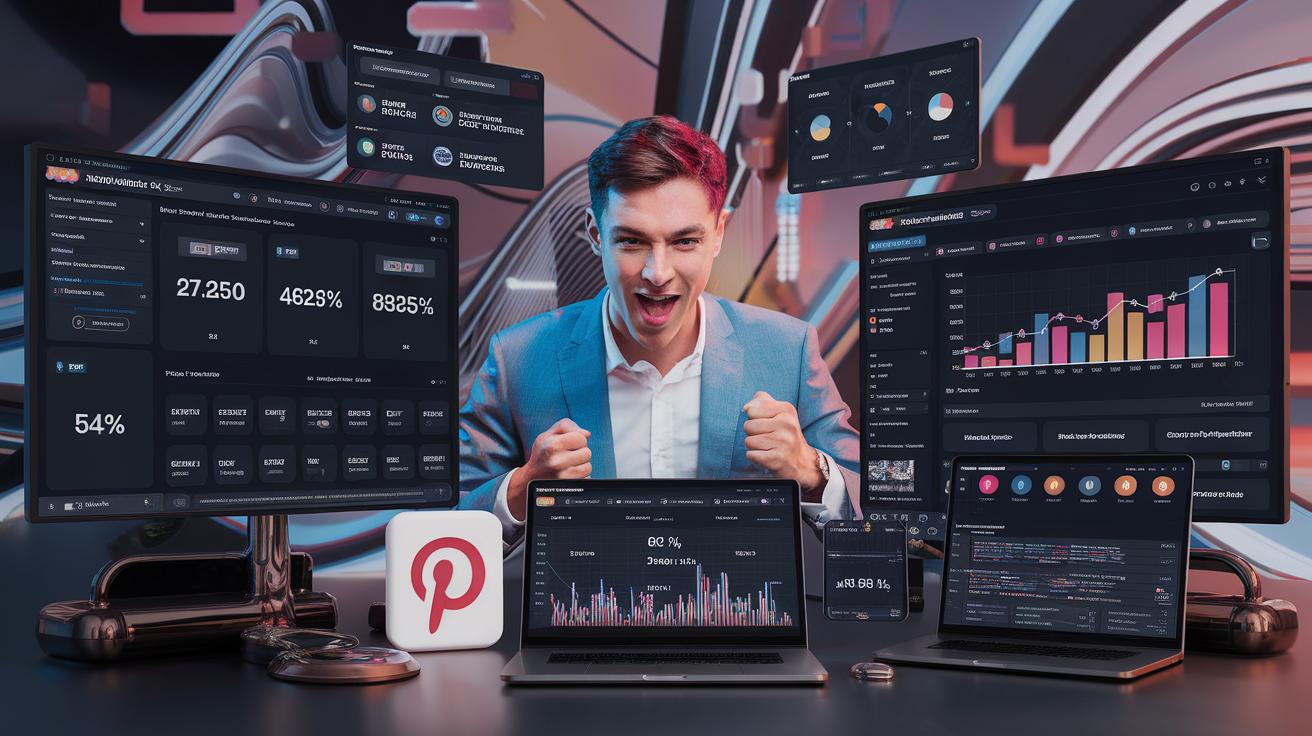Introduction
Creative marketing involves innovative strategies that resonate with target audiences, transforming routine promotions into captivating experiences. As businesses strive to stand out in a crowded digital space, leveraging platforms like Pinterest presents a unique opportunity to engage users visually. Pinterest’s distinct format allows marketers to showcase their products and ideas in a manner that captivates and inspires, varying from styles and fashion to DIY projects and informative resources.
This article walks you through the secrets behind creative marketing that specifically excel in harnessing Pinterest marketing trends. We will delve into effective strategies, identifying key aspects that can propel a brand’s visibility and engagement. By understanding Pinterest’s audience, utilizing its features, and crafting compelling content, marketers can enhance their creative marketing efforts, paving the way for sustained engagement and customer loyalty.
Understanding the Visual Appeal of Pinterest Mastering Engagement through Visual Content
Pinterest is uniquely tailored for visual storytelling, allowing brands to captivate their audience through images and graphics. The platform thrives on its ability to curate and showcase visual content that resonates deeply with users. While text-based content may engage readers on other platforms, Pinterest’s emphasis on visuals transforms it into a dynamic canvas where creativity shines. This unique characteristic fosters an engaging atmosphere, attracting users who are searching for inspiration, ideas, and products in a visually appealing format.
A fundamental aspect of Pinterest’s success in creative marketing lies in its user interface, which is designed to highlight compelling visuals. Users can browse through a never-ending stream of “pins” that are visually stimulating. This design encourages scrolling and engagement, leading to higher chances of users saving, sharing, or exploring the content further. The ‘pinning’ feature itself allows users to create curated boards filled with their favorite images, serving as a personal gallery of inspiration that they can refer back to at any moment.
Pinterest goes beyond simple image sharing; it incorporates user-generated content, allowing users to upload images alongside recipe ideas, DIY projects, fashion tips, and more. This interaction with the audience cultivates a sense of community and encourages users to engage actively. The platform’s algorithm selects and displays content based on user preferences, making it more likely that followers will see pins that align with their interests. This tailored experience keeps users engaged and returning for fresh ideas.
Another distinctive feature of Pinterest is its use of “Rich Pins,” which provide additional information directly on the pin. This functionality enhances user experience by offering more context, thereby increasing the likelihood of interaction. Rich Pins include details such as pricing, availability, and descriptions that transform a simple visual into a more informative asset. The combination of compelling visuals and rich content not only piques users’ interest but also drives action, be it purchasing a product or visiting a website.
Pinterest’s commitment to visual engagement renders it a powerful tool for brands aiming to master creative marketing strategies. By understanding and leveraging the platform’s unique features, brands can create an impactful presence and connect with their target audience on a deeper, more meaningful level.
Crafting Compelling Content for Pinterest Unlocking Creative Marketing Secrets
Strategies for Creating Visually Stunning and Engaging Content
Within the dynamic environment of Pinterest, quality content is not just an option; it is a necessity. To stand out amidst a sea of visuals, marketers must focus on crafting compelling pins that captivate users’ attention. A primary strategy involves using high-quality images that are bright, well-composed, and resonate with the target audience. Invest in professional photography or utilize high-resolution stock photos to ensure that your visuals shine. Creating engaging content also involves integrating colors and styles that mirror your brand identity, establishing a cohesive yet distinct presence on the platform.
Another effective strategy is leveraging vertical images. Research shows that pins with a 2:3 aspect ratio perform best, as they are more eye-catching when users scroll through their feeds. Consider add-on elements such as overlays, which can include text, quotes, or call-to-action prompts that invite engagement. However, it is critical to maintain clarity and not clutter your visuals; simplicity coupled with powerful visuals often leads to higher engagement rates.
The Importance of High-Quality Images and Branding
The essence of effective Pinterest marketing lies in high-quality imagery and a strong brand presence. High-resolution images serve not only to attract viewers but also to convey professionalism and trustworthiness. When clearly showcasing products or ideas, the details matter greatly—texture, colors, and backgrounds should all align to present a polished and appealing visual. Pinterest users are primarily in search of inspiration, so providing imagery that sparks creativity and conveys values can enhance user interaction.
Branding goes beyond just a logo; it encompasses a visual language that must be consistently applied across all pins. Using uniform fonts, colors, and image styles creates brand recognition, making it easier for users to identify your content amidst countless other pins. Maintaining this consistency helps foster a sense of community and loyalty among followers, paving the way for long-term engagement and potential conversions.
Captivating Pinterest content hinges on a blend of high-quality visuals, strategic composition, and consistent branding. Marketers who master these elements can effectively increase engagement, thereby unlocking the full potential of creative marketing within this unique visual platform.
Optimizing Pins for Maximum Reach Best Practices for Pinterest Marketing Success
To dominate Pinterest marketing trends, optimizing your pins for maximum reach is vital. This requires an understanding of how to effectively implement key elements such as keywords, hashtags, and descriptions into your pin strategy. Each of these components plays a crucial role in ensuring your pins don’t just exist but thrive in the user-driven algorithm of Pinterest.
Harnessing the Power of Keywords
Keywords are the foundation of visibility on Pinterest. When users search for ideas, they type in specific terms, which means your content must align with those search queries. Start by conducting thorough keyword research. Utilize Pinterest’s search bar to discover popular phrases related to your niche. When you identify high-traffic keywords, incorporate them into your pin titles and descriptions. Aim for a natural flow, avoiding keyword stuffing, which can detract from user experience and lead to engagement loss.
Utilizing Hashtags Effectively
Hashtags on Pinterest serve as categorizing tools that help your content reach interested audiences. Combining relevant keywords and hashtags can significantly increase your reach. Select a handful of specific hashtags relevant to your content, and use them sparingly in your pin descriptions. Consider hashtags that target niche markets, as broad hashtags can drown your content in a sea of competition.
Crafting Engaging Descriptions
The description of your pin offers a narrative that complements your visual content. Your goal should be to create a concise yet engaging summary that encourages clicks and shares. Focus on telling a compelling story about what users can expect by clicking the pin. Include your keywords naturally within this description, maintaining a tone that resonates with your target audience. Inviting action-oriented phrases, such as “Learn how to…” or “Discover the secrets to…,” can increase engagement rates.
Visual Considerations for Optimization
While keywords, hashtags, and descriptions are crucial, visual appeal remains paramount. Ensure that your images are high quality and relevant to the keywords you are targeting. Use vertical images with a 2:3 aspect ratio, as these tend to perform better than square or horizontal images. Adding text overlay can also help convey the message quickly, allowing users to grasp the core idea even before they click.
By focusing on these key elements, you set a solid foundation for your Pinterest marketing efforts, making your pins more discoverable and engaging to users. Mastering the art of optimization not only enhances your visibility but also boosts your overall engagement, leading to greater success on the platform.
Leveraging Trends and Seasonal Content Mastering Pinterest Marketing Trends
Marketers looking to strengthen their presence on Pinterest must harness the power of trends and seasonal content. Timely and relevant content resonates with users, making it imperative to stay attuned to what’s currently popular or on the horizon. Leveraging these trends allows brands to not just participate in the conversation but to lead it, effectively drawing users’ attention to their offerings.
Harnessing Trends for Maximum Impact
Identifying and utilizing trends involves understanding Pinterest’s unique culture. Users often engage with content that mirrors their current interests or seasonal celebrations. Keeping a finger on the pulse of these themes can help marketers create relevant content that attracts clicks and conversions. Monitoring Pinterest’s “Trending” section or using analytical tools to track what users are searching for can provide insights into emerging trends.
For instance, during the back-to-school season, brands can curate boards filled with school supplies, fashion ideas, and organizational tips that capitalize on this period of consumer behavior. Similarly, for holidays like Halloween or Christmas, creating themed content such as DIY decorations or gift-giving ideas can enhance engagement. The key lies in the timely promotion of such content, ideally weeks or even months in advance, allowing users to discover and save these ideas well before the actual events.
The Importance of Seasonal Themes
Seasonal themes are invaluable for establishing relevance and connection with audiences. Seasons often dictate user preferences, transforming Pinterest into a platform where ideas related to seasonal activities thrive. These periods present excellent opportunities for brand storytelling that aligns with user emotions and aspirations. Some effective strategies include:
- Creating visually appealing seasonal graphics that reflect current trends.
- Utilizing seasonal keywords in pin descriptions and titles to enhance discoverability.
- Collaborating with seasonal influencers who can amplify messages more broadly.
Posting consistently throughout each season ensures that brands maintain visibility and relevance. Engaging users with seasonal promotions or exclusive collections can make interactions feel personal and timely, enhancing the overall user experience. Ultimately, by strategically focusing on trends and seasonal content, marketers can ensure they stay top of mind for their audience, bridging the gap between browsing and buying on Pinterest.
Building Community Engagement through Pinterest
Fostering a Community Around Your Brand
Establishing a vibrant community on Pinterest requires strategy and intent. As a visual platform, Pinterest empowers brands to create connections with users through inspiring imagery and meaningful content. To cultivate deeper relationships, brands should prioritize interaction. Engaging directly with followers by responding to comments, asking questions, and encouraging them to share their perspectives fosters a sense of belonging. This two-way communication encourages users to invest emotionally in the brand, making them more likely to engage with future posts.
Feedback plays a pivotal role in building community. Brands can leverage Pinterest by conducting polls, asking for input on design choices, or seeking recommendations for new products. This not only makes followers feel valued, but it also provides valuable insights into the preferences of the audience. Implementing feedback can lead to enhanced user satisfaction and loyalty, as followers see their opinions reflected in brand offerings.
Collaboration and Shared Interests
Collaboration is another effective method for engaging a community on Pinterest. Brands can partner with influencers, creators, or other brands that share similar values and target demographics. Collaborative boards can be created to showcase a range of ideas, products, and inspirations, which benefits both parties by broadening their reach. These boards can feature guest contributions, sparking diverse engagement and attracting different user segments.
Creating themed boards that resonate with community interests, such as DIY projects, sustainability tips, or wellness strategies, can drive more interaction. By curating content around shared passions, brands can position themselves as thought leaders within niche markets, fostering community through shared values.
Brands should also consider user-generated content as a potent tool for community building. Encouraging followers to share their experiences with the brand through pins can amplify authenticity. Running contests or challenges that invite users to create themed boards or share their creative ideas allows for greater community participation. This encourages followers to interact not just with the brand but with each other, enriching the overall community experience.
Engagement on Pinterest cannot be overlooked. It’s not merely about pinning beautiful visuals; it’s about creating a meaningful dialogue and collaborative space that invites users to connect with the brand and each other. The more actively a brand encourages interaction, gathers feedback, and pursues collaborations, the more likely it will thrive in the ever-changing world of Pinterest marketing.
Measuring Success in Pinterest Marketing Strategies
Defining Key Performance Indicators
Determining the effectiveness of your Pinterest marketing efforts requires a clear understanding of key performance indicators (KPIs). These metrics are crucial for assessing how well your strategies resonate with your audience and achieving your overall marketing goals. Common KPIs for Pinterest include impressions, clicks, saves, and engagement rates. Impressions reflect how many times your content has been displayed, while clicks indicate user interest by assessing how many times users visited your profile or pinned content. Saves measure the extent to which users are saving your Pins to their boards, revealing the content’s appeal and relevance. Engagement rates, calculated as the percentage of interactions (saves, clicks, comments) relative to impressions, provide a deeper insight into how engaging your content truly is.
Utilizing Analytics Tools
Incorporating analytics tools is vital for effective measurement of your Pinterest marketing strategies. Pinterest itself offers a robust set of analytical tools through Pinterest Analytics, which provides insights into your audience demographics, Pin performance, and overall account activity. You can identify which pins are driving the most traffic to your website and understand user behavior, allowing for adjustments in your content strategy accordingly. Third-party tools like Tailwind and Hootsuite also enhance analytics capabilities, enabling you to schedule posts and engage more effectively with your audience. These platforms often feature in-depth reporting and optimization suggestions tailored to your content style, making it easier to adapt strategies based on performance data.
Apart from traditional metrics, tracking conversion rates—such as the percentage of users who complete a desired action after interacting with your Pins (e.g., purchasing a product or signing up for a newsletter)—is essential. This data provides your business with a tangible measure of how successful your Pinterest marketing initiatives are in driving revenue and achieving your goals.
Adapting Strategies Based on Insights
Once you have gathered sufficient data from your KPIs and analytics, it’s vital to iterate on your strategies. Regularly reviewing performance and refining your approach can lead to increased engagement and higher conversion rates. This adaptive approach involves experimenting with different types of content, layouts, and scheduling times based on when your audience is most active. The insights gained from analytics not only help in optimizing existing content but also assist in planning future campaigns effectively. By remaining flexible and responsive to the data, your brand can maintain a strong position in the ever-changing landscape of Pinterest marketing.
Conclusions
Mastering creative marketing on Pinterest requires a refined approach that combines visually appealing content with strategic audience engagement. By utilizing Pinterest’s unique features and understanding the platform’s user behaviors, brands can develop effective campaigns that not only attract attention but also foster community and loyalty. The insights shared in this article serve as a foundation for marketers aiming to leverage Pinterest as a powerful tool in their creative marketing arsenal.
As we wrapped up our exploration of Pinterest marketing trends, it becomes clear that success lies in the details. By continually monitoring trends, experimenting with new ideas, and staying adaptable, marketers can dominate the Pinterest landscape. Embracing creativity and innovation ensure that brands not only participate in the conversation but also lead it, making impactful connections with their audiences.
















